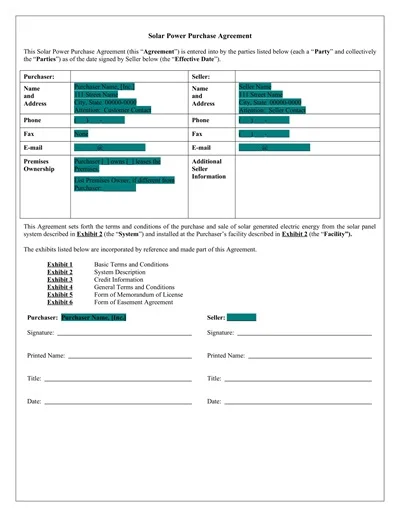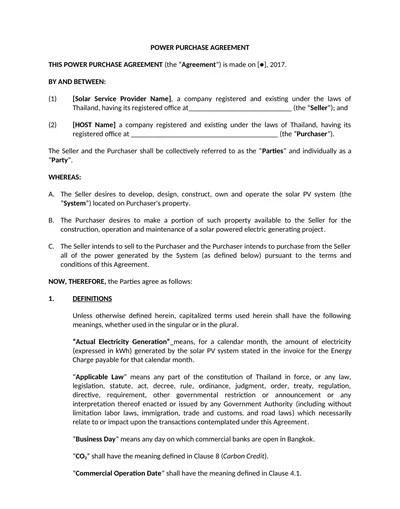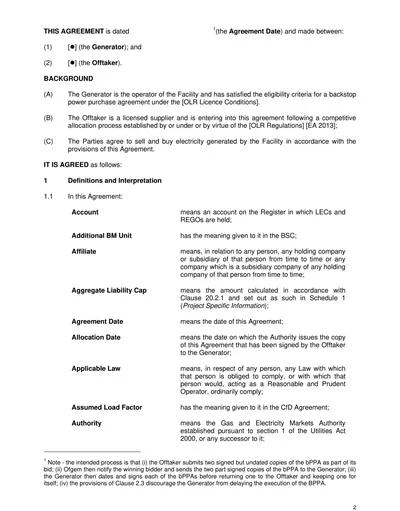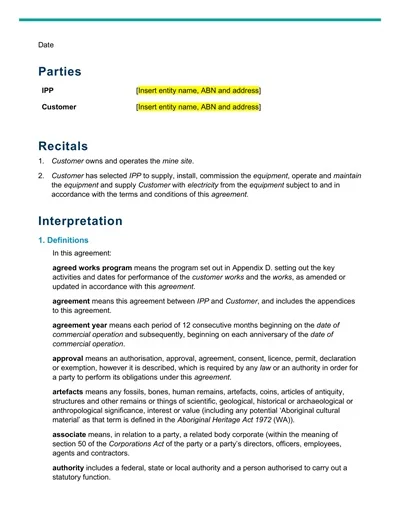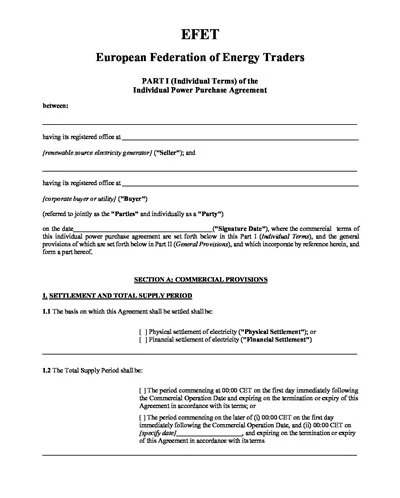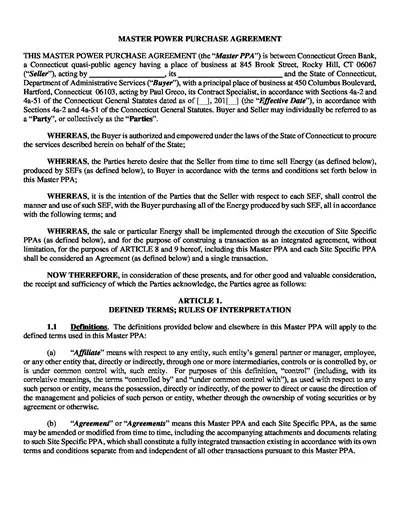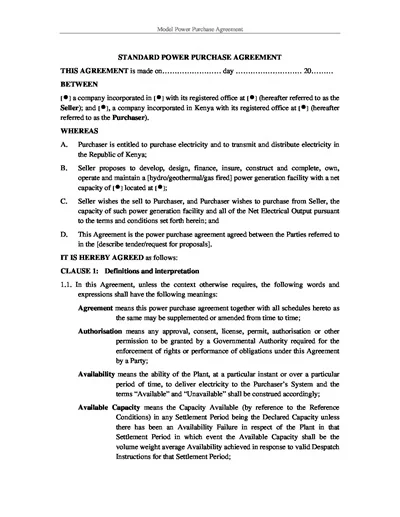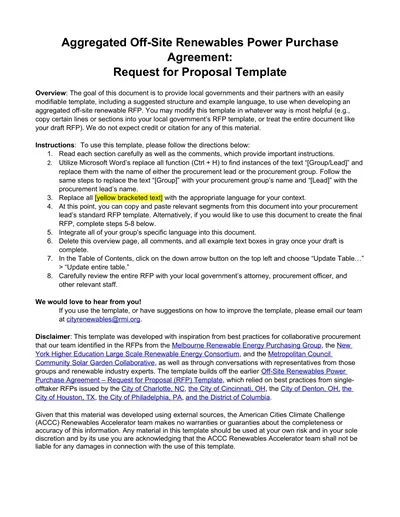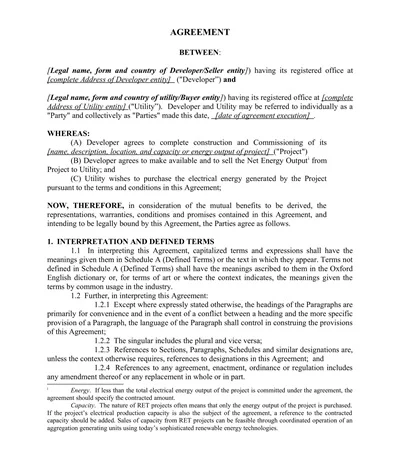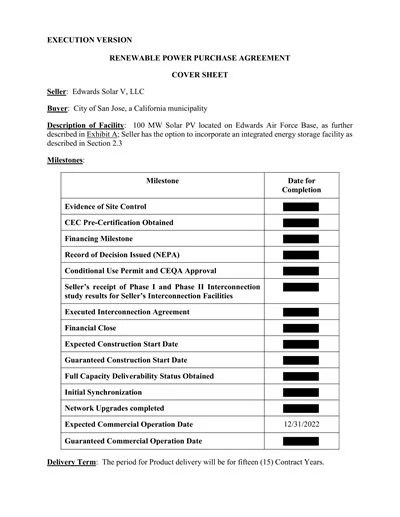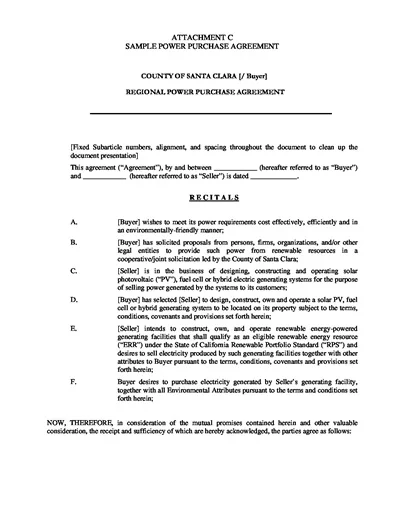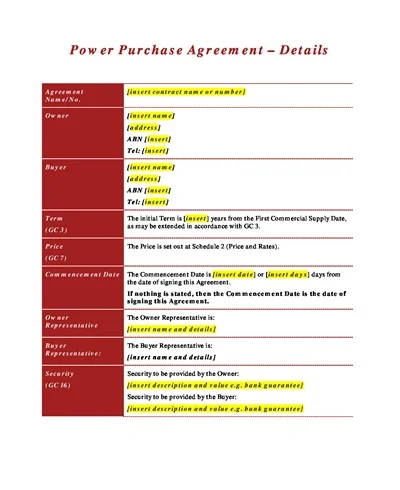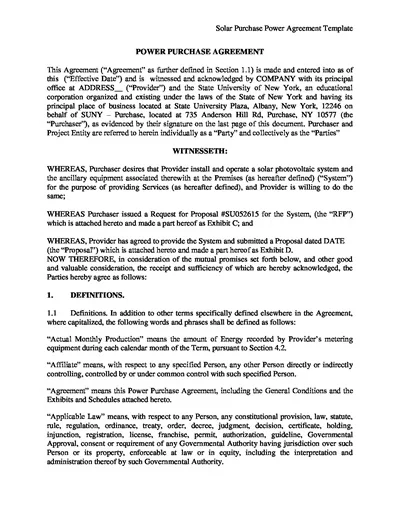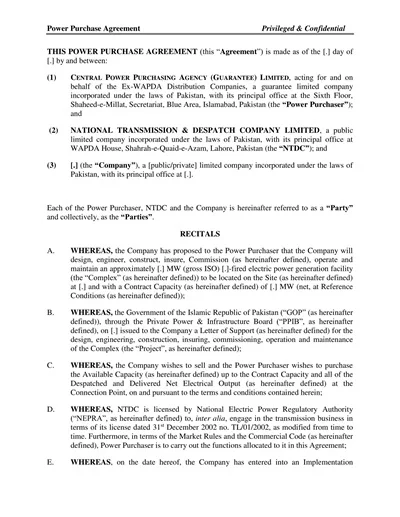26+ Free Power Purchase Agreement Templates (PDF, DOC)
A Power Purchase Agreement Template is a standardized document that outlines the terms and conditions under which power is generated and sold. This binding contract is between a power producer (seller) and a purchaser (buyer), usually specifying the amount of energy to be supplied, the rate at which it is to be sold, and the duration of the agreement.
PPAs are instrumental in the energy sector, facilitating the financing and development of renewable energy projects by ensuring a steady income stream for the power producers while guaranteeing a fixed, often competitive price for the energy supplied to the purchaser.
Download Free Power Purchase Agreement Templates
What is a Power Purchase Agreement?
A Power Purchase Agreement (PPA) is a financial arrangement between a power generator, usually a company that produces renewable energy, and a power purchaser, typically a utility or end-user. Under a PPA, the purchaser agrees to buy electricity from the producer at a predetermined price for a specific period.
This arrangement provides financial stability for the generator by ensuring a consistent revenue stream and allows the purchaser to lock in energy costs, potentially at rates lower than market prices. PPAs are instrumental in facilitating the financing of renewable energy projects by guaranteeing a market for the electricity generated.
Types of Power Purchase Agreements
Power Purchase Agreements (PPAs) play a crucial role in the energy sector by facilitating the purchase of electricity between two parties. They vary in structure and purpose, accommodating various energy projects and policies.
Below are the main types of PPAs:
1. Traditional Utility PPAs
- Definition: These are long-term agreements between power generators and utility companies. The utility acts as an intermediary, purchasing electricity from the generator at a negotiated price and then selling it to its customers.
- Benefits: Ensures a stable revenue stream for power producers and provides utilities with a reliable electricity supply.
2. Corporate PPAs
- Definition: Corporate PPAs are contracts directly between a renewable energy generator and a corporate buyer. These agreements are becoming increasingly popular as companies seek to reduce their carbon footprint.
- Benefits: Enables corporations to secure long-term, cost-effective renewable energy supplies while supporting the expansion of green energy projects.
3. Virtual PPAs (VPPAs)
- Definition: In a Virtual PPA, the physical flow of electricity is separated from the financial transactions. The buyer pays the seller a fixed price for the electricity generated, but it is sold into the wholesale market.
- Benefits: Offers flexibility and access to renewable energy markets without requiring direct physical delivery. It’s particularly beneficial for companies in deregulated energy markets.
4. Merchant PPAs
- Definition: These PPAs are agreed upon by a generator and a marketer or trader rather than a utility or corporate buyer. The power produced is sold directly into the wholesale electricity market.
- Benefits: Allows generators to capitalize on fluctuating market prices, although this comes with higher financial risk due to price and demand variability.
5. Community Solar PPAs
- Definition: Community solar projects allow multiple customers to benefit from a single, shared solar array, with participants entering into PPAs with the project’s owner or developer.
- Benefits: Provides access to solar power for individuals and businesses unable to install solar panels on their property, promoting wider renewable energy adoption.
Each type of PPA has its own set of negotiations, terms, and conditions tailored to meet the needs of the specific parties involved, indicating the versatile nature of how electricity can be traded and financed in today’s energy landscape.
Key Components of a Power Purchase Agreement
Key Components of a Power Purchase Agreement (PPA) include the following essential elements:
- Price Structure: A detailed breakdown of the pricing for the power supplied, including base charges, escalators, and any conditions that might affect pricing over the agreement term.
- Term Length: The duration of the agreement, typically ranging from 10 to 25 years, specifying the start date and the conditions under which the contract can be renewed or terminated.
- Energy Volume: The amount of energy that the buyer is committed to purchasing, which can be stated as a fixed amount, a percentage of production, or as an as-produced basis.
- Delivery Point: The specified location where the energy transfer will occur can impact transmission costs and risks.
- Credit Requirements: Security or guarantees required from both parties to ensure financial obligations are met, including conditions for collateral, letters of credit, or parent guarantees.
- Performance Guarantees: Provisions to ensure the project meets specified performance standards, including mechanisms for compensation if these standards are not met.
- Risk Allocation: Clauses that specify which party bears the risk for various elements of the project, such as delivery delays, increased costs, and force majeure events.
- Regulatory and Legal Compliance: Stipulations to ensure all aspects of the project and its operation comply with local, state, and federal regulations.
Each component plays a critical role in shaping the PPA, leading to a balanced and equitable agreement for both the buyer and the seller of the energy.
Benefits of Power Purchase Agreements
Power Purchase Agreements (PPAs) offer several benefits, making them an attractive option for businesses and organizations investing in renewable energy. Firstly, PPAs provide financial predictability. By locking in energy rates for the duration of the agreement, companies can avoid the volatility of energy prices in the open market, enabling more accurate long-term budgeting.
Secondly, PPAs require no upfront capital investment, allowing entities to access renewable energy sources without significant initial expenditure. This aspect is particularly advantageous for organizations seeking to reduce their carbon footprint but lack the resources for large-scale investments in renewable energy infrastructure. Lastly, PPAs contribute to corporate sustainability goals, as they allow companies to support the development of renewable energy projects indirectly, reducing their overall environmental impact without the need to manage or maintain energy-producing assets themselves.
How to Create a Power Purchase Agreement Template
Creating a Power Purchase Agreement (PPA) template can be valuable for businesses and organizations involved in energy projects. It provides a framework for negotiating and finalizing the terms of an agreement between an energy producer and a purchaser.
To create an effective PPA template, follow these steps:
1. Define the Scope of the Agreement
Start by specifying the parties involved, the project details, and the purpose of the Power Purchase Agreement (PPA). This section sets the foundation for all subsequent terms and conditions.
2. Establish the Terms of Energy Pricing
Detail the pricing structure for the energy to be sold and purchased. Include any provisions for price adjustments over the term of the agreement, such as escalators or de-escalators.
3. Set the Delivery and Scheduling Terms
Clarify how and when the energy will be delivered, including any scheduling requirements or limitations. This section should address transmission, interconnection, and any grid-related issues.
4. Outline the Quality and Reliability Standards
Specify the expected quality and reliability standards for the energy supplied, including any penalties for non-compliance. This ensures that both parties have clear expectations regarding the quality of energy to be delivered.
5. Detail Credit and Payment Terms
Describe the credit requirements, billing procedures, and payment terms. This includes how and when payments will be made and any conditions that could affect the payment obligations.
6. Incorporate Legal and Regulatory Compliance
Ensure the agreement complies with all relevant laws, regulations, and industry standards. This section should address any permits, licenses, or approvals required for the project.
7. Define Terms and Termination Conditions
State the duration of the PPA and the conditions under which it can be terminated or extended. This includes provisions for early termination, breaches of contract, and any associated penalties or remedies.
8. Include Dispute Resolution Mechanisms
Propose mechanisms for resolving disputes that may arise during the agreement term. Options may include negotiation, mediation, arbitration, or litigation.
9. Add Miscellaneous Provisions
Address any additional terms or conditions not covered in other sections. This may include force majeure events, confidentiality obligations, and assignment or transfer conditions.

